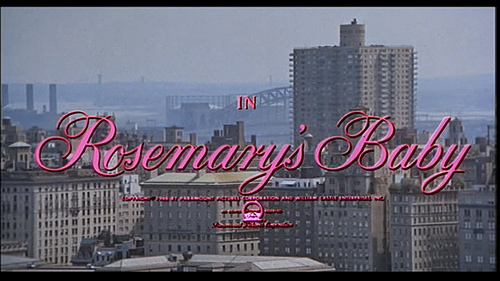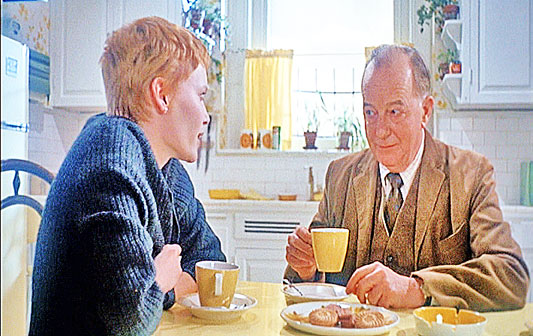
Roman Polanski’s Rosemary’s Baby (1968)
By Thomas S. Flowers
There is a strange, perverse, serendipitous feeling watching Rosemary’s Baby. This first of Roman Polanski’s American films opens with a New York City urban landscape, outstretched and panned across, as if what we see is some malevolent box metal toy, wound up and played on the tune of some woman humming an intently sweet and ambiguous lullaby. But instead of some creepy jack-in-the-box, we get something much different in the end. Much more sinister. And utterly human, regardless of its supernatural parentage. The movie makes it almost too easy to find some deeper quality or meaning to the story of Rosemary’s baby, from the presence of evil surrounding an alienated city, to spousal rape, to the occult even (to get to the nitty-gritty) or the overshadowed, all-consuming feeling of a small frail Nebraskan girl being swallowed alive by the even more deadpan banality of the city. But, before we get too comfortable with our new neighbors, let’s walk the halls of the apartment house on West 72nd Street, and see where those eerily demonic chants are really coming from.
As shown above, Rosemary’s Baby opens on a panoramic view of an urban city with a disturbingly sweet lullaby — “la-la-la” — playing in the background, and opening credits in a cursive script and hot pink. Immediately I think of girls, as in pink for girls, blue for boys. Even if you’ve never watched Rosemary’s Baby, the title kinda gives away the central theme, childbirth. What waits for us following the opening credits and the bird-like drifting to the young couple walking through an archway, remains a mystery, all but for one thing — whatever happens, it has to do with Rosemary’s baby. What happens with Rosemary’s baby, we do not know; all we know is that everything that will be set up will be for the sole purpose of telling a story regarding Rosemary’s baby. Savvy? Let us continue.

Moving into the apartment, we are introduced to Guy Woodhouse (John Cassavetes), a struggling New York City actor, and his very meek-looking wife, Rosemary (Mia Farrow). We also discover they are newlywed and are considering (maybe more than that) starting a family. The apartment is very gothic and old-looking, perhaps as old as the city itself, with roots as deep as the transit system underneath them. The previous tenant was an elderly woman (in fact, most of the fictional tenants of West 72nd Street are elderly) who passed away recently in a coma. Her apartment remains as she left it, the furniture collecting dust, the herbs in her kitchen garden browned and frail, and notes of “I can no longer associate myself…” partially complete. And there is one more item: a large heavy secretary cabinet is blocking one of the hallway closets. Odd, we think, because of the placement of the furniture that would seem too heavy for an elderly woman to move by herself. But we laugh it off. Perhaps the old duck really had gone senile before passing. Regardless, the next time we see Rosemary she’s nearly begging, but not that hard really, for Guy to agree to lease the lavish apartment.
Guy Woodhouse is many things. Some of those things are quite vile and selfish. Of this, we’ll see intimately later on. But there are moments when we get a look at a guy (no pun intended) who would do whatever it took to make his wife happy. It’s evident he’s a city guy(again, no pun) and she’s a small-town girl. Her eyes shine with that jubilant expectation of a glamorous life in a rich landscape of modernity. We see her giddiness and are nearly jumping up and down with her. In this lush, big-city dream apartment, what’s not to love?

Next, just before the montage “moving-in” scene, we are introduced to one of the few pleasant characters that fill the void. At the dinner table of close friend Edward “Hutch” Hutchins (Maurice Evans), a scholar of sorts and author of children’s adventure stories, warns them about the history of the apartment the Woodhouse’s have just leased, a history of witchcraft and cannibalism and dead babies in the basement. The story is quite chilling, but the young couple does not seem phased by it, as if they may be accustomed to hearing fancy tales that may or may not be entirely true from their friend Hutch — a type of friend, family or otherwise, that is not entirely clarified, though he does seem to favor Rosemary over Guy. And we’ll see later on that he is more her friend over her husband in many instances that do not last long enough on screen as they should.
Following dinner, we get our first montage scene. The drab, dark gothic is replaced by bright whites and sunny yellow wallpaper and new (at least in 1968) furniture and appliances. Everyone is happy, though Guy does seem a little apprehensive about the move and its costs, mostly due to being passed over for parts in his acting career. Day or weeks go by, we’re not entirely sure, montage in all, and next we see the missus doing laundry in the basement of the apartment building. The basement is stereotypically creepy and Rosemary is happy to share the space with a new face, Terry Gionoffrio, who she mistakes for Victoria Vetri, an actual real person made famous by Playboy magazine and the real name of the actress playing Gionoffrio. Terry admits she gets mistaken for Vetri “all the time,” but she “doesn’t see the resemblance.” I have to assume that this actually stirred some laughs back in 1968, or at least I hope so because this joke went right over my head when I first watched the movie (heck, even when I screened the movie for my fifth time). To get this joke, watching Rosemary’s Baby in 2016, you have got to be a historian or a really big fan of Playboy magazine.

Well, moving on . . . .
The two become fast friends and commit to doing laundry together to avoid being alone in the “creepy” basement. And while the creepy basement is an overused trope in horror, it’s overused for a reason. It’s believable. It solidifies the realism of the movie. We don’t want to be in that basement alone either. And thus, we’re given another of many human connections to Rosemary’s baby.
Unfortunately, tragedy strikes . . . [click here to read Part 2 of Thomas S. Flowers’ essay].
 Author’s Bio: Thomas S. Flowers is the published author of several character-driven stories of dark fiction. He resides in Houston, Texas, with his wife and daughter. He is published with The Sinister Horror Company’s horror anthology The Black Room Manuscripts. His debut novel, Reinheit, is published with Shadow Work Publishing, along with The Incredible Zilch Von Whitstein and Lanmò. His Subdue Series, including both Dwelling and Emerging, is published with Limitless Publishing, LLC. In 2008, he was honorably discharged from the U.S. Army where he served for seven years, with three tours served in Operation Iraqi Freedom. In 2014, Thomas graduated from University of Houston-Clear Lake with a BA in History. He blogs at machinemean.org, where he does author interviews and reviews on a wide range of strange yet oddly related topics.
Author’s Bio: Thomas S. Flowers is the published author of several character-driven stories of dark fiction. He resides in Houston, Texas, with his wife and daughter. He is published with The Sinister Horror Company’s horror anthology The Black Room Manuscripts. His debut novel, Reinheit, is published with Shadow Work Publishing, along with The Incredible Zilch Von Whitstein and Lanmò. His Subdue Series, including both Dwelling and Emerging, is published with Limitless Publishing, LLC. In 2008, he was honorably discharged from the U.S. Army where he served for seven years, with three tours served in Operation Iraqi Freedom. In 2014, Thomas graduated from University of Houston-Clear Lake with a BA in History. He blogs at machinemean.org, where he does author interviews and reviews on a wide range of strange yet oddly related topics.




One thought on “Cults in Horror Movies: “Rosemary’s Baby” (1968) – by Thomas S. Flowers (Part 1)”
Comments are closed.